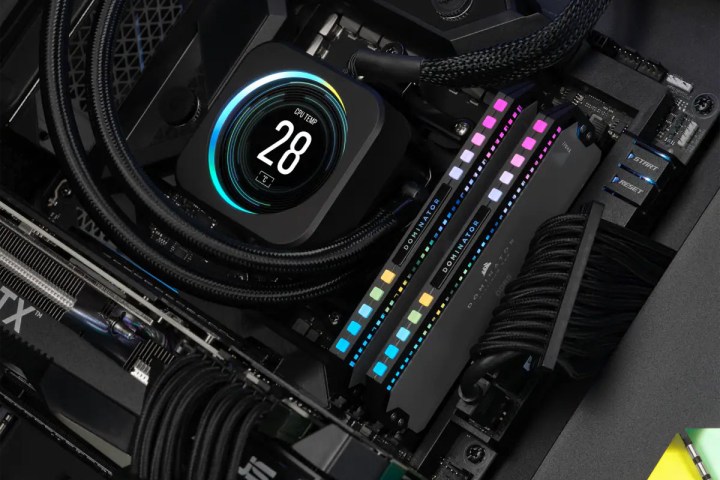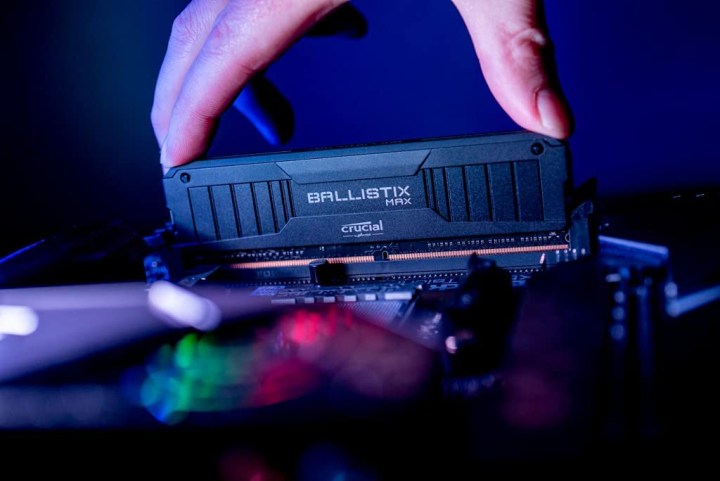
The two main memory types for modern computers are DDR4, and DDR5. Together they span a number of processor and motherboard generations across desktop PCs and laptops, and though DDR4 might be the more popular memory type for now, that is slowly changing. With the release of Ryzen 7000-series processors and Intel’s 12th, 13th, and 14th generations, DDR5 memory is becoming far more prevalent.
With AMD you don’t have a choice, but for now, with Intel you do. That can make it hard to decide whether DDR4 or DDR5 are the better choice for your next system. And is worth upgrading to something newer to get access to this newer, faster memory?
Here’s a comparison between DDR5 and DDR4 to help you make an informed choice regarding the most suitable memory type for your upcoming upgrade.
Pricing and availability
DDR5 RAM pricing has seen a massive reduction since its introduction in 2021. Then, you were looking at over $1,000 for 16GB. Today, most sell for around $3 per gigabyte, which means you can grab 16GB of DDR5 RAM for less than $50. That’s a massive price cut and means that not only can you get the bare minimum of memory for very little investment, but you can consider upgrading to large and faster kits too. It’s not even that expensive to get 32GB or even 64GB in 2024.
If you want greater speed and better timings when stacked against the best DDR4 RAM, you’ll have to pay more, though. For example, a decent 16GB kit in the 5600MHz range will run you around $40-50. But if you go up to 32GB of dual-channel DDR5 RAM at 5600MHz, you’re looking at spending nearly $100-120. Still, that’s incredible value considering where prices were just a few years ago, and with the latest generations of CPU benefitting from faster and faster memory, upgrading to a bigger and faster kit could be the way to go to boost your PC’s performance.
DDR5 is already standard with Intel’s Alder Lake 12th generation and the more recent Raptor Lake 13th generation and its 14th generation refresh, while on the other side AMD’s Ryzen 7000 Zen 4 CPU exclusively uses DDR5 RAM. Future generations of Zen 5 CPUs from AMD, and Arrow Lake processors from Intel, are likely to be DDR5 exclusives.
Acquiring DDR5 RAM for your custom PC is now as effortless as obtaining DDR4. Simply explore options at retailers like Best Buy, Amazon, Newegg, or your preferred electronics store, where you’re likely to find a wide array of choices available.
Our hands-on tests
We tested both DDR4 and DDR5 on Intel’s 12th-gen i9-12900K in May, and our tests found DDR5 was an average of 11% faster across different testing benchmarks.

The results depended largely on the benchmarking software used. As you can see, DDR5 performed only 7% faster than DDR4 in a 3D Mark Time Spy test but blew DDR4 out of the water in both Geekbench 5 tests.
It’s important to note that DDR5 gives Alder Lake an advantage, which means Intel’s 12th-gen chips work best when coupled with DDR5 RAM. You’ll see similar performance advantages of higher-speed DDR5 memory with newer Intel 13th and 14th generation processors, too, since they are both newer architectures that can better take advantage of higher memory speeds, and come with better native support for faster RAM. There are diminishing returns, with the very fastest kits mostly useful for benchmarking rather than real world performance advantages, but the option is there if you want it.
Performance
Memory performance is dependent on a number of factors, but the biggest differentiator between different kits is speed.
This is measured in Megatransfers per second, or MT/s, although it’s often given as an MHz rating. In either case, the effective performance number is the same, so it can be used interchangeably.
The DDR4 standard is available in a range from 1,600MHz to a peak of 3,200MHz. However, manufacturers have introduced DDR4 memory kits that surpass these limits significantly. By harnessing automated overclocking through extreme memory profile (XMP), these kits have enabled even higher speeds. While kits capable of 4,000MHz are not uncommon, there have been instances of exceptional kits exceeding 5,000MHz. The tangible performance benefits of such high-speed memory might not be obvious, leading to these kinds of kits being both rare and costly, yet they do indeed exist.

DDR5, on the other hand, has its own range of standards, starting at 4,800MHz and running up to 6,400MHz. As with DDR4, though, there will be faster memory available in the future, and manufacturers have already begun announcing kits far in excess of the DDR5 standards. Various manufacturers have shown off kits that can operate in excess of 8,000 MHz, and some proof of concepts even go north of 12,000 MHz.
DDR5’s raw speed far surpasses that of even the fastest DDR4 at the top end, while the midrange hovers around the 5,000MHz mark, which is like the top end of DDR4 RAM.
Timings are the other side of the performance coin. They control the latency of certain memory functions and can have quite a dramatic effect on the real-world performance of memory. Although they are almost always looser on higher-frequency memory and will be on DDR5, it is unlikely that they will cause DDR5 to perform worse than DDR4.
DDR5 also improves the channel architecture of the memory, using two smaller channels, rather than a single larger one, to handle memory access. The width of the channel remains the same, but two smaller channels may improve efficiency, which could help give DDR5 another performance edge over its last-generation rivals.
Capacity
One of the major changes with DDR5 at the architectural level is that the dies are twice as dense compared to DDR4. When combined with new chip designs, that means that where DDR4 memory chips could be manufactured at up to 16GB, DDR5 chips can be made with capacities up to 64GB. That should lead to larger-capacity memory sticks. While 128GB of memory in a single stick seems a likely option, Samsung has a whopping 512GB DDR5 stick.
There are very few mainstream applications for such memory capacities, but if the option is there for greater stick capacities, it makes longer-term upgrades a little easier to plan out and opens up the possibility of greater memory capacities on smaller systems like Mini-ITX builds.
Want to know how much RAM you need? Check out our guide.
Power and thermals
As has been the case with every generation of DDR memory that came before, DDR5 demands less power for its improved performance. Where DDR4 has a standard voltage demand of 1.2v, DDR5 sips just 1.1v. This plays a part in reducing power consumption in mobile devices like laptops and tablets.
Typically, a lower voltage would suggest the electronics would run cooler, but that is not the case with DDR5. DDR5 kits have the voltage regulator for the memory on the modules themselves, rather than on the motherboard.
That, combined with the improved performance and much greater density of the memory chips, means DDR5 runs hotter than DDR4. This means you’ll want to make sure you have compatible heat sinks before installing DDR5 RAM.
DDR5 is better, but at what cost?
DDR5’s performance reaches more than double the fastest DDR4 modules. Coupled with Intel 12th-gen, 13th-gen, and 14th-gen processors or the AMD Ryzen 7000-series processors, PCs are faster and more powerful than ever before. The lower prices today are a real bonus to anyone looking to upgrade.
DDR5 has some issues with heat performance, but it’s not anything a well-cooled machine can’t handle. DDR4 is a familiar standard found in most computers built since 2015, and the top end will serve you well. However, if you want to future-proof your computer, you should upgrade to DDR5. This is the new standard, and DDR4 is quickly becoming obsolete.
Editors’ Recommendations

